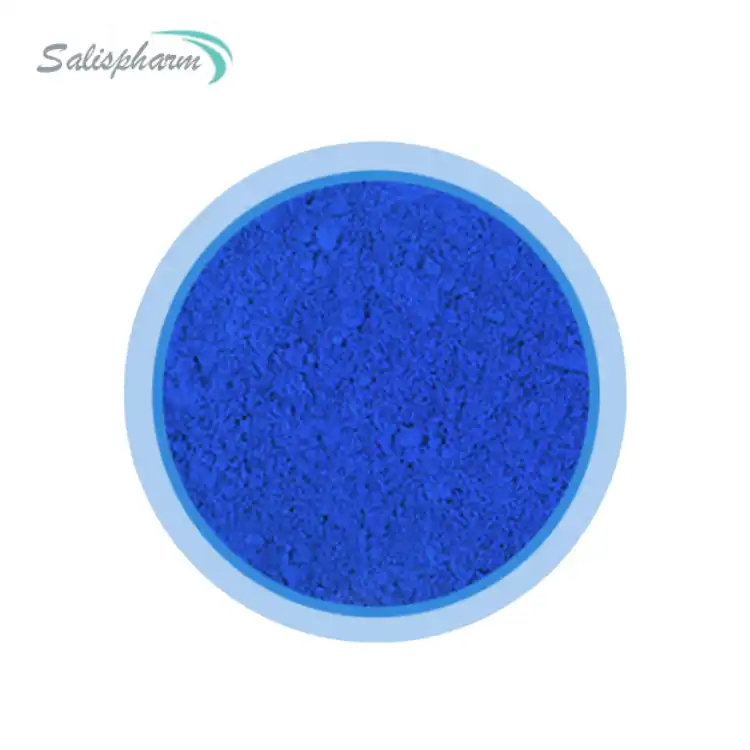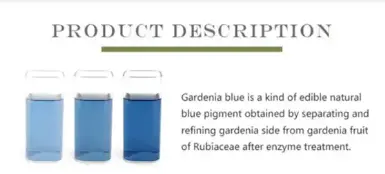Gardenia Blue Powder, derived from the fruit of the Gardenia jasminoides plant, has gained popularity as a natural dye for fabrics. This eco-friendly alternative to synthetic dyes has piqued the interest of many textile enthusiasts and environmentally conscious consumers. In this blog post, we'll explore the effectiveness of Gardenia Blue Powder for dyeing fabrics, its application methods, and how it compares to other natural dyes.

How do you use Gardenia Blue Powder to dye fabric?
Using Gardenia Blue Powder to dye fabric is a relatively straightforward process, but it requires careful preparation and execution to achieve the best results. Here's a step-by-step guide to using Gardenia Blue Powder for fabric dyeing:
- Prepare the fabric: Start by washing the fabric to remove any dirt, oils, or sizing that might interfere with the dye absorption. For natural fibers like cotton, linen, or silk, you may want to pre-mordant the fabric using alum or another mordant to help the dye bind more effectively.
- Create the dye bath: Dissolve the Gardenia Blue Powder in warm water, using about 1-2 tablespoons of powder per liter of water. The exact ratio may vary depending on the desired intensity of the color. Stir well to ensure the powder is fully dissolved.
- Heat the dye bath: Gradually heat the dye bath to about 60-70°C (140-158°F). Avoid boiling, as this can damage the dye molecules and affect the color outcome.
- Add the fabric: Submerge the pre-wetted fabric in the dye bath, ensuring it's fully covered. Gently agitate the fabric to promote even dye distribution.
- Maintain temperature: Keep the dye bath at a consistent temperature for 30-60 minutes, stirring occasionally to prevent uneven dyeing.
- Rinse and wash: After the desired color is achieved, remove the fabric from the dye bath and rinse it in cool water until the water runs clear. Wash the dyed fabric separately in mild detergent and hang it to dry away from direct sunlight.
It's important to note that the final color may vary depending on factors such as fabric type, mordanting process, and water pH. Experimenting with different variables can help you achieve the desired shade of blue.
For more vibrant or darker shades, you can repeat the dyeing process or increase the concentration of Gardenia Blue Powder in the dye bath. Some dyers also find success in combining Gardenia Blue Powder with other natural dyes to create unique color variations.
What fabrics work best with Gardenia Blue Powder dye?
Gardenia Blue Powder is versatile and can be used on a variety of fabrics, but some materials tend to yield better results than others. Understanding which fabrics work best with this natural dye can help you achieve optimal color outcomes and longevity.
Natural fibers: Gardenia Blue Powder generally performs best on natural fibers, particularly those of plant origin. These include:
- Cotton: As one of the most common and versatile fabrics, cotton readily accepts Gardenia Blue dye, producing a range of beautiful blue hues.
- Linen: This durable fabric also takes the dye well, often resulting in a slightly more muted, elegant blue tone.
- Hemp: Similar to linen, hemp fabrics can achieve lovely blue shades with Gardenia Blue Powder.
- Bamboo: This sustainable fabric option works well with the dye, often producing softer, more pastel-like blue tones.
Protein fibers: While plant-based fibers are ideal, some protein fibers can also be dyed effectively with Gardenia Blue Powder:
- Silk: This luxurious fabric can produce stunning results with Gardenia Blue dye, often yielding a lustrous, deep blue color.
- Wool: Although not as common, wool can be dyed with Gardenia Blue Powder, typically resulting in more muted, heathered blue tones.
Synthetic fibers: Gardenia Blue Powder is less effective on synthetic fibers like polyester, nylon, or acrylic. These materials often require special dyes and processes to achieve vibrant, long-lasting colors. However, blended fabrics containing both natural and synthetic fibers may take the dye to some extent, with the natural fibers absorbing more color than the synthetic components.
To achieve the best results with Gardenia Blue Powder, consider the following tips:
- Pre-wash fabrics: Remove any sizing or finishes that might interfere with dye absorption.
- Use a mordant: Especially for protein fibers, using a mordant like alum can help the dye bind more effectively to the fabric.
- Experiment with pH levels: The pH of your dye bath can affect the final color. Try adding a small amount of vinegar or baking soda to adjust the pH and see how it impacts the shade.
- Consider fabric weight: Lighter-weight fabrics may require less dye or shorter immersion times compared to heavier materials.
By choosing the right fabric and following proper dyeing techniques, you can achieve beautiful and long-lasting results with Gardenia Blue Powder dye.
How does Gardenia Blue Powder compare to other natural dyes?
When considering natural dyes for fabric coloration, it's essential to understand how Gardenia Blue Powder compares to other options in terms of color intensity, fastness, ease of use, and environmental impact. Let's explore how this unique dye stacks up against some popular alternatives:
Indigo: Perhaps the most famous natural blue dye, indigo has been used for thousands of years.
- Color range: Indigo typically produces deeper, more saturated blues compared to Gardenia Blue Powder.
- Fastness: Indigo is known for its excellent colorfastness, often surpassing Gardenia Blue in this aspect.
- Process: Indigo dyeing requires a more complex reduction process, making it less user-friendly for beginners compared to Gardenia Blue Powder.
Woad: Another traditional source of blue dye, primarily used in Europe.
- Color range: Woad produces lighter, more pastel blues similar to Gardenia Blue Powder.
- Availability: Woad is less readily available than Gardenia Blue Powder in many regions.
- Environmental impact: Both woad and Gardenia Blue Powder are considered environmentally friendly options.
Logwood: A tree-based dye that can produce purplish-blue hues.
- Color range: Logwood offers a wider range of blue to purple shades compared to Gardenia Blue Powder.
- Mordant dependency: Logwood typically requires more extensive mordanting than Gardenia Blue Powder.
- Sustainability: Gardenia Blue Powder may be considered more sustainable, as it's derived from fruit rather than tree heartwood.
Saxon Blue: A modern natural dye made from indigo and sulfuric acid.
- Ease of use: Saxon Blue is easier to use than traditional indigo, similar to Gardenia Blue Powder in this respect.
- Chemical processing: Unlike Gardenia Blue Powder, Saxon Blue involves chemical processing, making it less appealing to some natural dye enthusiasts.
Gardenia Blue Powder offers several advantages over these alternatives:
- Simplicity: It's generally easier to use than indigo or woad, making it more accessible for beginners.
- Eco-friendliness: As a fruit-derived dye, it's considered highly sustainable and environmentally friendly.
- Unique color: The blue produced by Gardenia Blue Powder has a distinctive, often more muted quality compared to other blue dyes.
- Versatility: It can be used on a wide range of natural fibers without extensive pre-treatment.
However, Gardenia Blue Powder does have some limitations:
- Color intensity: It may not achieve the deep, saturated blues possible with indigo.
- Colorfastness: While generally good, its colorfastness may not match that of indigo or some synthetic dyes.
- Availability: Depending on your location, Gardenia Blue Powder might be less readily available or more expensive than some alternatives.
Conclusion
Gardenia Blue Powder offers a unique combination of ease of use, eco-friendliness, and attractive color results. While it may not surpass all other natural blue dyes in every aspect, its overall profile makes it an excellent choice for many textile artists and eco-conscious consumers. As with any dye, experimentation and practice will help you determine if Gardenia Blue Powder is the right choice for your specific projects and preferences.
If you are also interested in this product and want to know more product details, or want to know about other related products, please feel free to contact lea_slsbio@163.com,WhatsApp+86 13193326505.

References
1. Cardon, D. (2007). Natural Dyes: Sources, Tradition, Technology and Science. Archetype Publications.
2. Dean, J. (2010). Wild Color: The Complete Guide to Making and Using Natural Dyes. Watson-Guptill.
3. Flint, I. (2008). Eco Colour: Botanical Dyes for Beautiful Textiles. Murdoch Books.
4. Liles, J. N. (1990). The Art and Craft of Natural Dyeing: Traditional Recipes for Modern Use. Univ. of Tennessee Press.
5. Boutrup, J., & Ellis, C. (2018). The Art and Science of Natural Dyes: Principles, Experiments, and Results. Schiffer Publishing.
6. Fletcher, K. (2014). Sustainable Fashion and Textiles: Design Journeys. Routledge.

